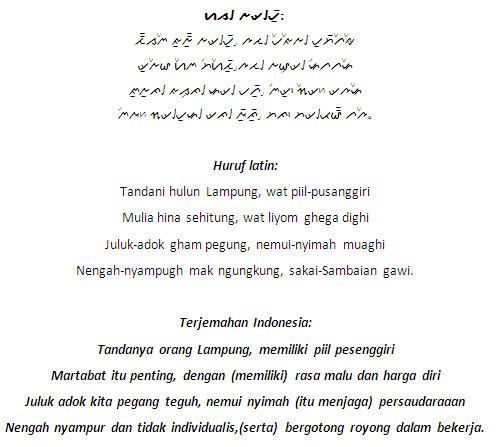Ethnicity Lampung people | ||
 | ||
Native speakers 1.5 million (2000 census) Language family AustronesianMalayo-Polynesian (MP)Nuclear Malayo-PolynesiaSunda-SulawesiLampung | ||
Lampung is the language of the Indonesian province of Lampung at the southern tip of Sumatra. It is a dialect cluster with two main dialects, perhaps distinct enough to be considered distinct languages: Abung/Pepadun (Lampung Nyo) and Pesisir/Say Batin (Lampung Api). A third, Komering, is sometimes considered part of Lampung Api, by others a distinct language. Lampung Api is the prestige variety.
Contents
- Phonology
- Gemination
- Metathesis
- Vowels
- Writing system
- Comparison chart
- Universal Declaration of Human Rights
- References
Before the introduction of the Roman script, Lampung was written in a script called "Aksara Lampung" or "Had Lampung", which is a variant of the Ulu scripts used throughout central and south Sumatra. The script is seldom used today but is taught in schools throughout Lampung as a means of preserving its linguistic history.
Phonology
Voiceless stops occur in word-initial, word-medial, and word-final position. Word-final stops are generally unreleased. Voiced stops generally do not occur word-finally. There seems to be only moderate evidence for a phonemic glottal stop. /r/ has a range of phonetic realizations but is most often a velar or uvular fricative [x],[ɣ], [χ],[ʁ].There is minor disagreement between the two earlier phonologies about /r/, described as an apical trill by Abdurrahman and as a voiceless velar fricative by Walker. Walker stated that this phoneme (written as /x/ in 1976 and as /r/ in his 1975 word lists) occurs in all major environments and is sometimes voiced intervocalically. Walker (1976:3) noted that [r] (apical trill) ‘occurs in unassimilated loanwords’ and alternates with [x] in many cases.
The nasals occur in word-initial, word-medial and word-final positions, with the exception of /ɲ/, which does not occur word-finally. /l/ occurs in word-initial, word-medial, and word-final position. /w/ and /y/ occur word-initially and word-medially and, depending on one's analysis, word-finally as part of diphthongs discussed below. Both phonemes occur word-medially in positions where they are not considered as transitions from [u] and [i] respectively.
Gemination
Gemination, particularly consonant gemination, is a prominent feature in Lampung.It is not easy to generalize except to say that gemination happens most frequently in Nyo, less so but still frequently in Api, and almost never (at least as we and others have transcribed it) in Komering. Lampung people often did not agree among themselves which lexemes exhibit gemination but one can see that the phenomenon as we documented it clusters around specific lexemes. Several cases each of gemination are recorded for every consonant in medial only position (either between vowels or as part of a consonant cluster) except /ɲ/, /ŋ/, /s/, /w/ and /y/. Gemination is most frequently associated with one of two related environments: 1) penultimate schwa; and 2) reduction of voiceless nasal-stop clusters to the stop component. In this case other vowels are in some isolects neutralized to schwa. Gemination therefore can be significant for reconstruction.
Metathesis
Metathesis seems to have been a fairly common process in Lampungic. From the correspondence sets can be counted at least twenty lexemes in which metathesis occurred in one or more of the Lampungic isolects. It most frequently occurred with consonants, e.g. *rihuʔ ‘cloud’ → hiruk and *gǝlar ‘name’ → gǝral, but also with vowels, often with some fairly complex transformations, e.g. *siwa ‘nine’ → suay and *lahia ‘ginger’ → liha.
Vowels
Abdurrahman posits the phoneme /o/ for Komering. However, we submit that most if not all occurrences of [o] in Komering can be more accurately analyzed as allophones of /ə/.
Walker posits the phoneme /e/ in addition to /i/ and /ə/ for Way Lima. However, is to reanalyze most occurrences of [e] as allophones of /i/. Walker apparently did not preserve the distinction between [ə] and [e] in his word lists, as both phones are written using e. In addition, the examples he gives in his phonology for /e/ are likely all borrowed words. Vowel sequences do occur, but a syllable break always occurs between them in our data. Such sequences are distinguished from the diphthongs /aw/, /ay/, and /uy/.
Writing system
The Lampung language is written in an abugida, or alphasyllabary, called Aksara Lampung or Had Lampung. It has 20 induk surat (19 consonants and one vowel), and 13 anak surat (diacritics). Had Lampung has been influenced by the Pallava script and the Arabic script. Belonging to the Brahmic family of scripts, it shares similarities with the Rejang alphabet, Rencong alphabet, Sundanese alphabet, and the Kawi script of Java.
The Lampung script which is used and taught today is the result of a revision of the old Lampung script.
Comparison chart
Below is a chart of Lampung and other languages comparing thirteen words.
Universal Declaration of Human Rights
This is Article 1 of the Universal Declaration of Human Rights (Pernyataan seduniya tentang Hak Dasar Jelema)
